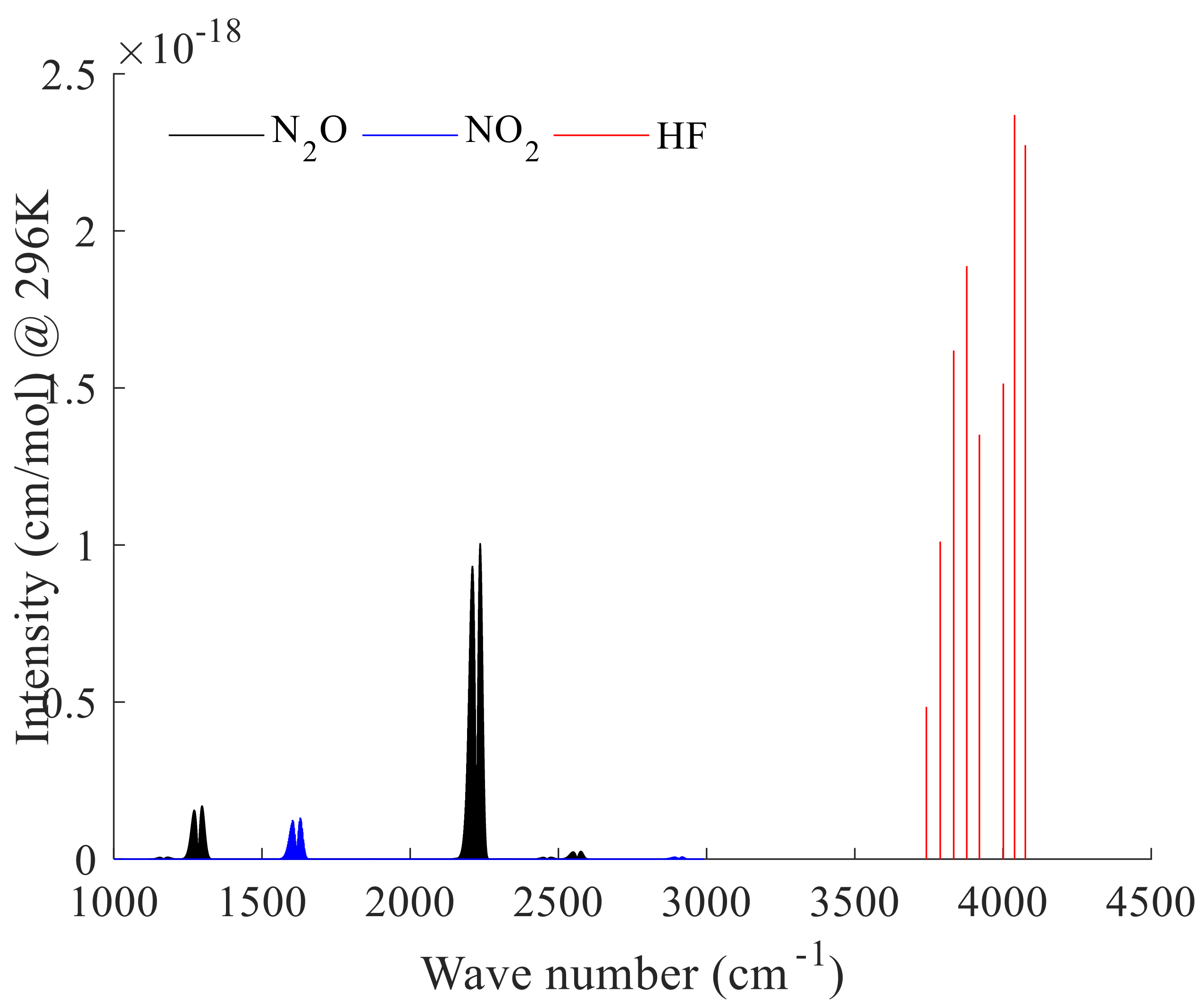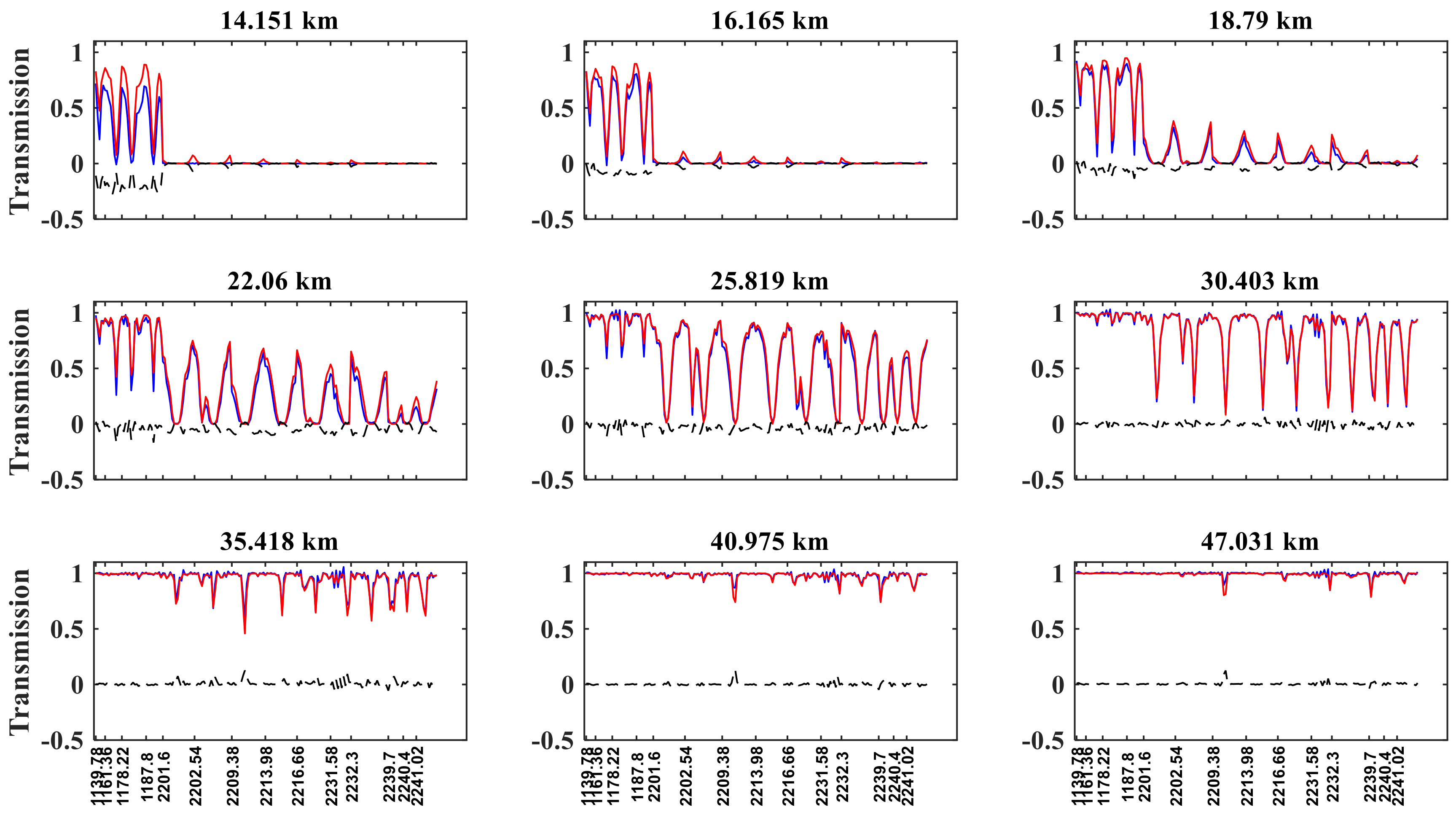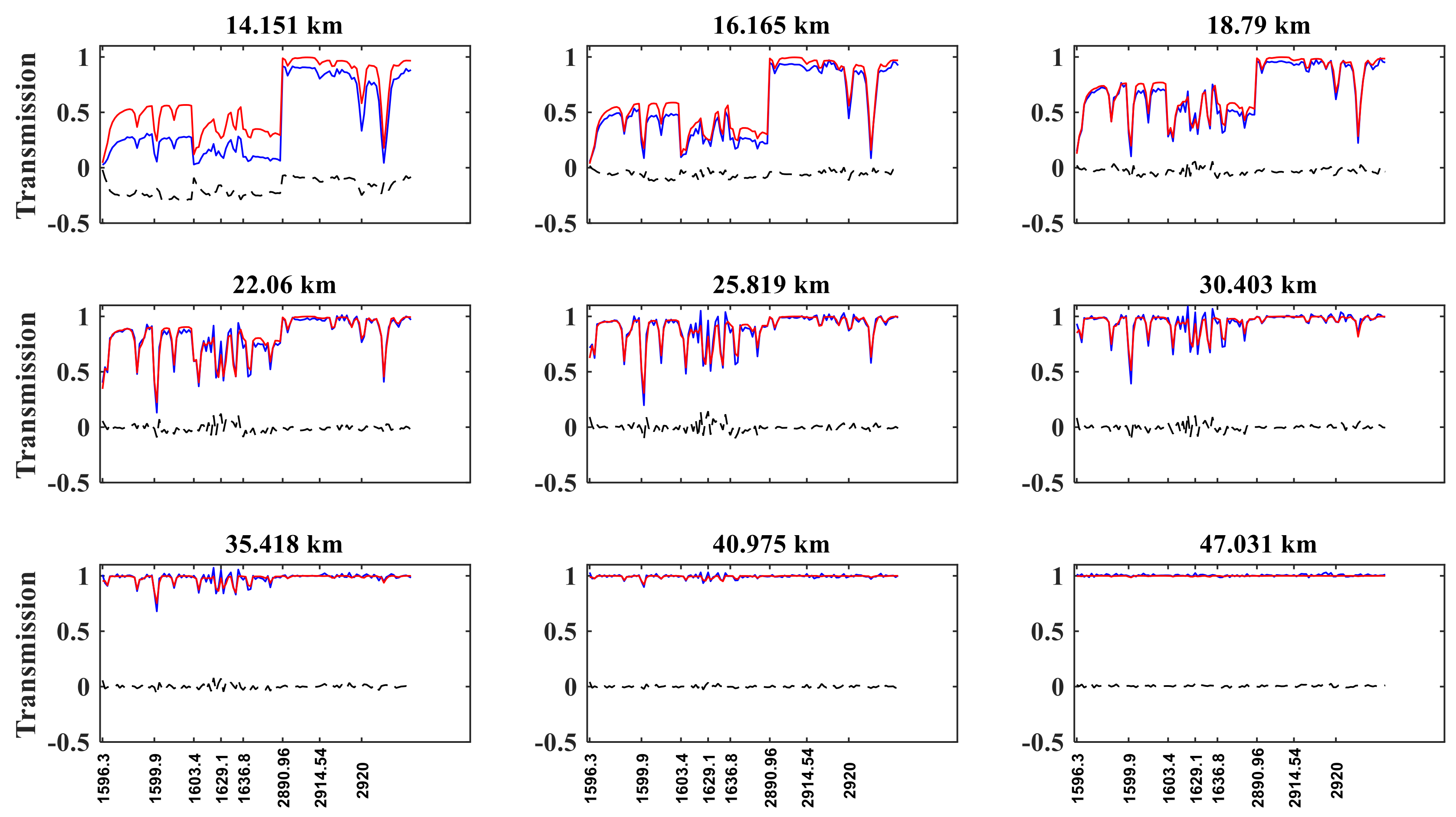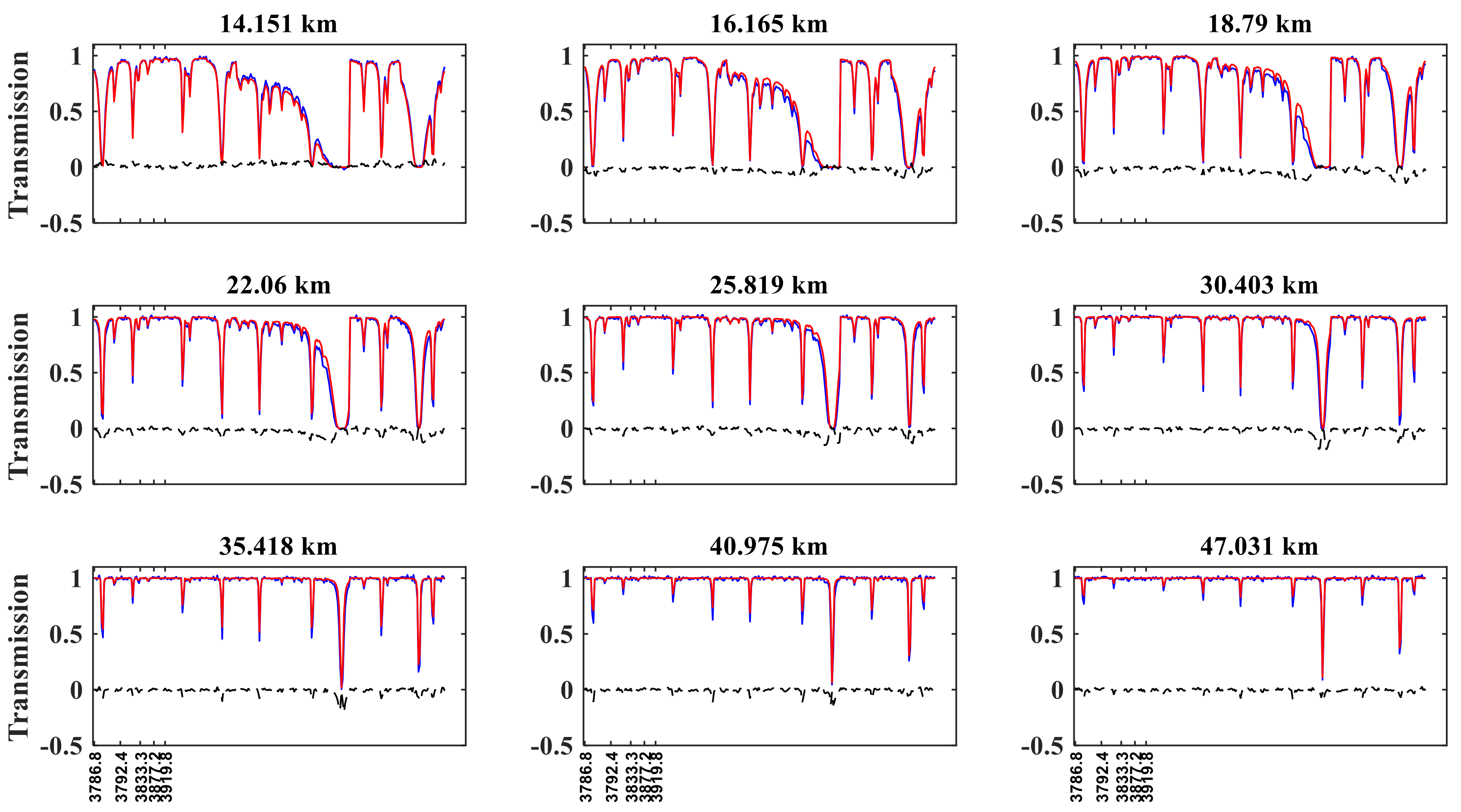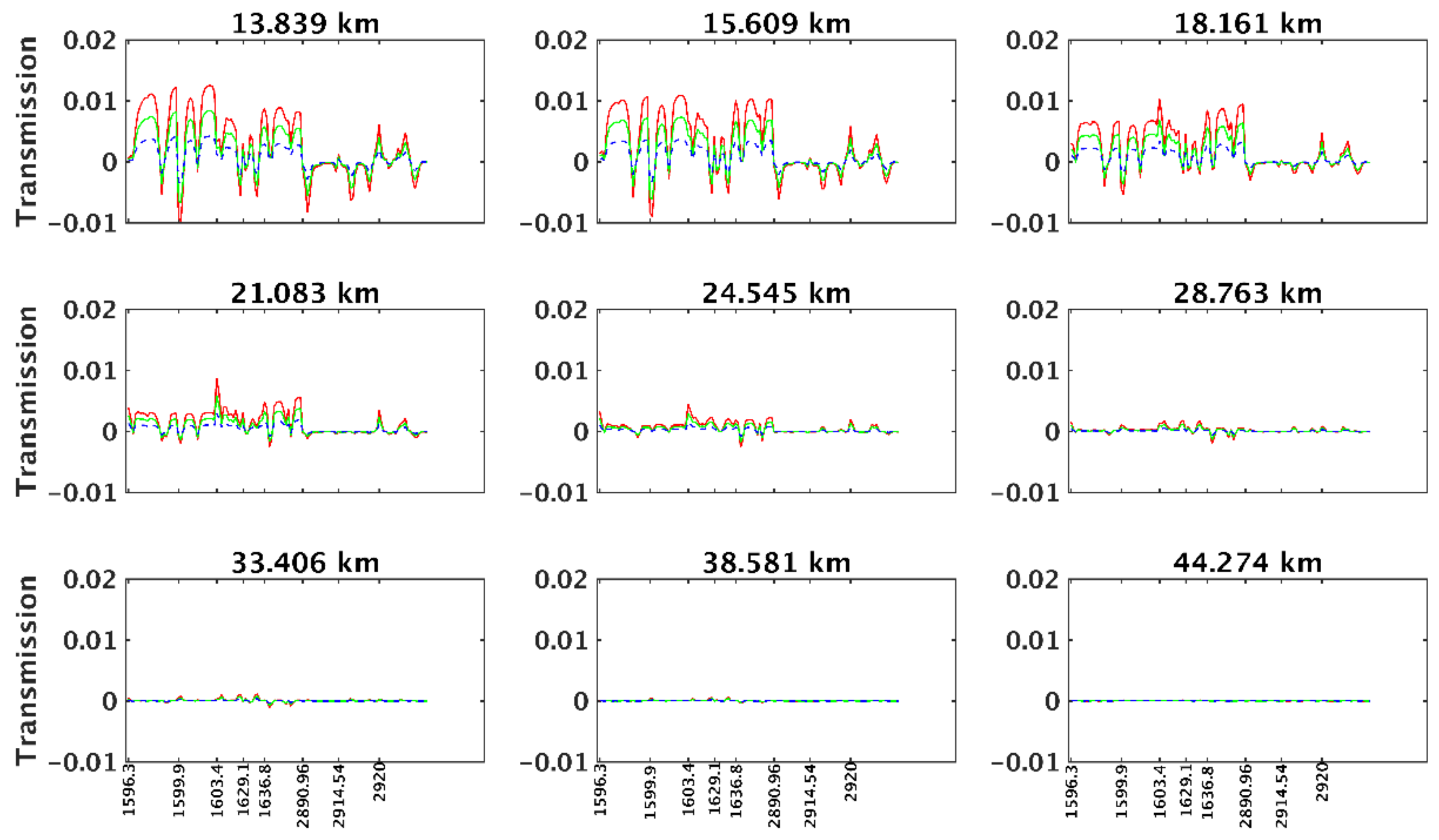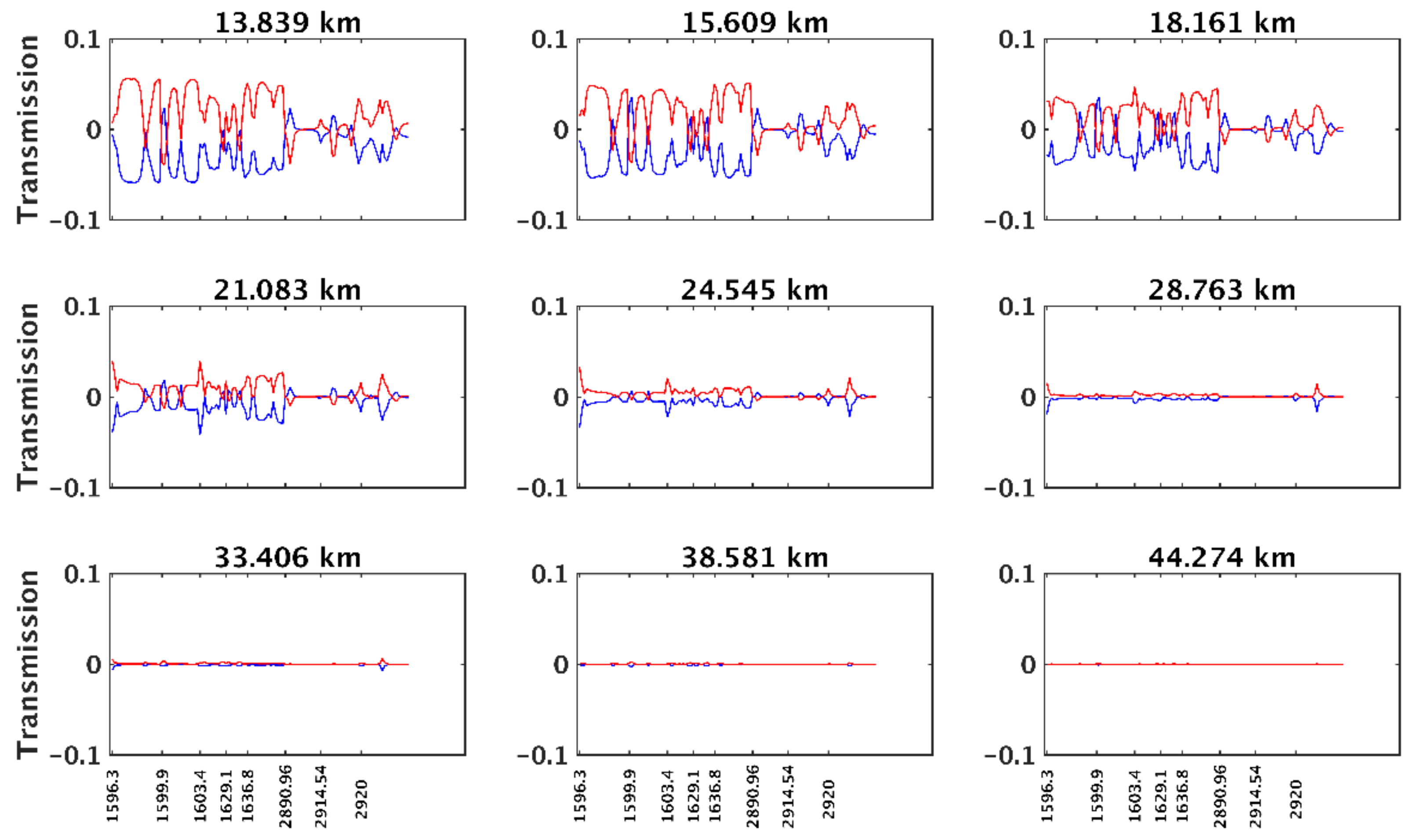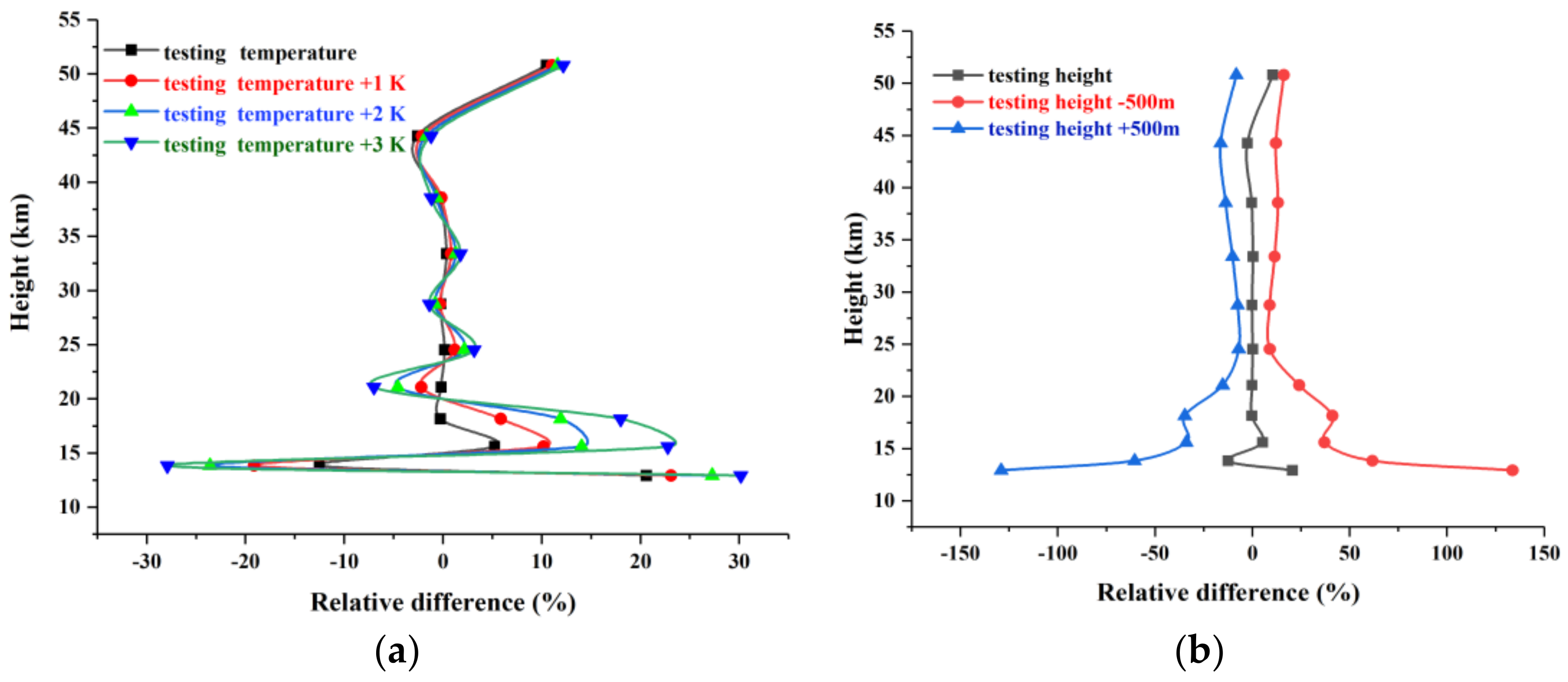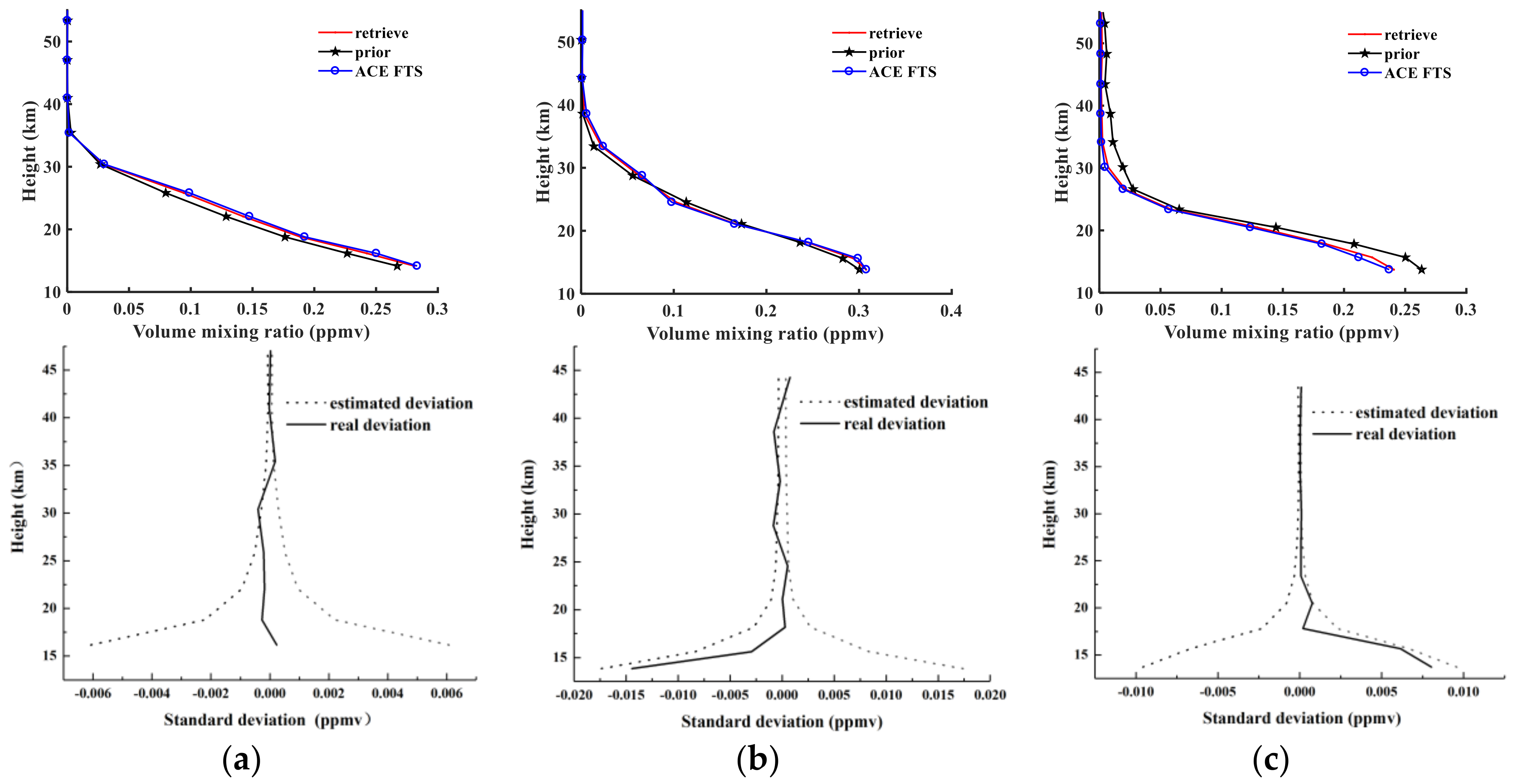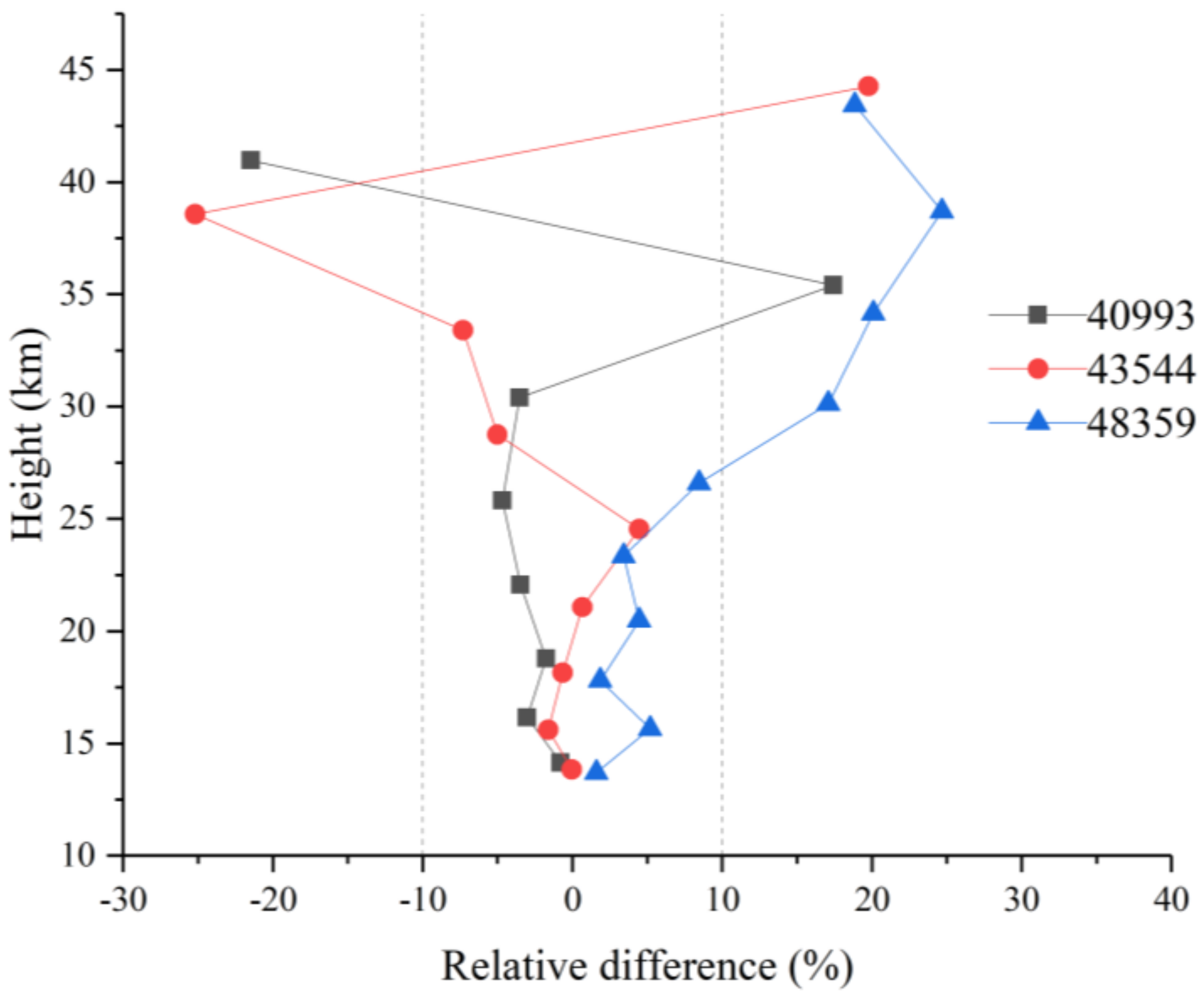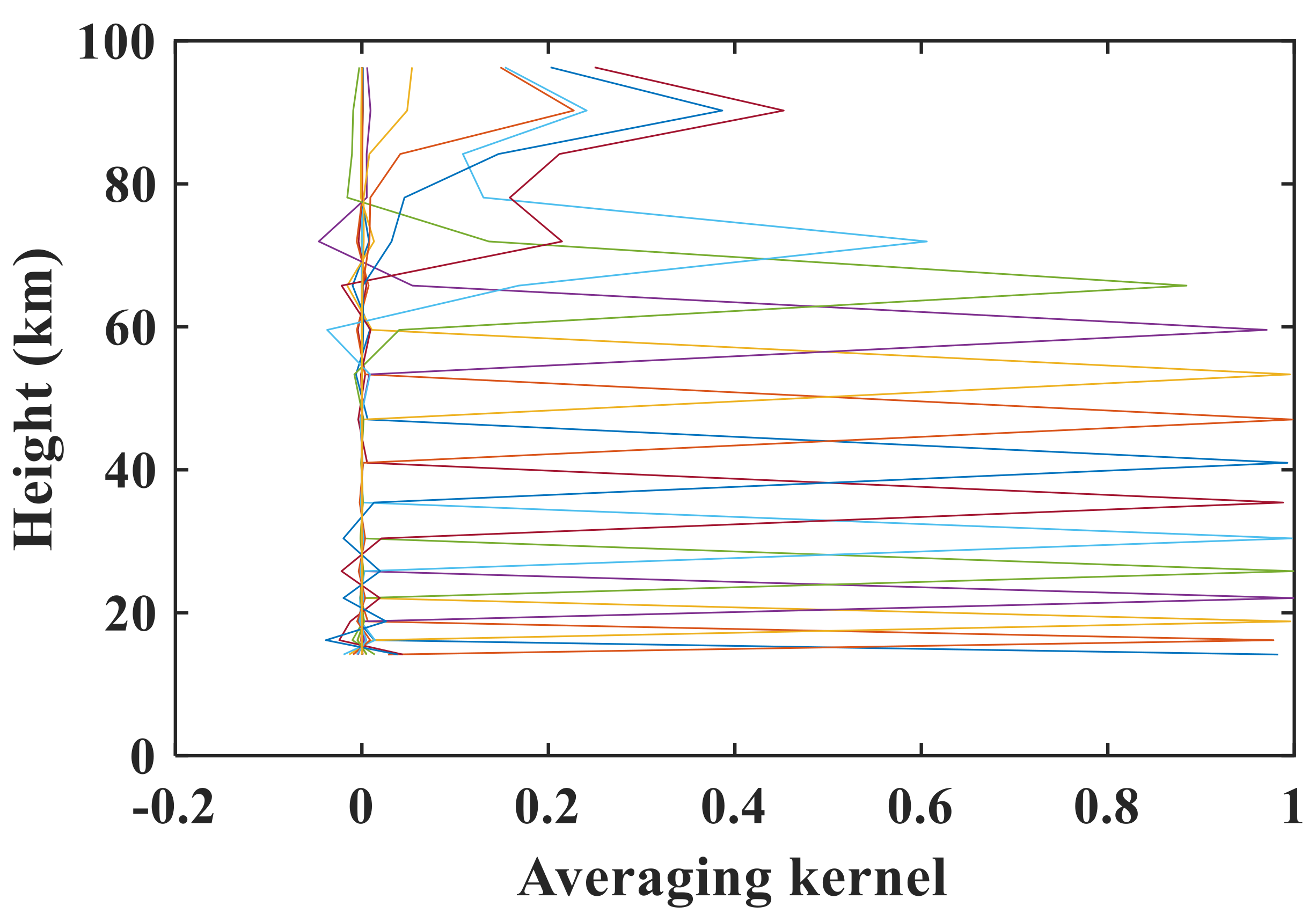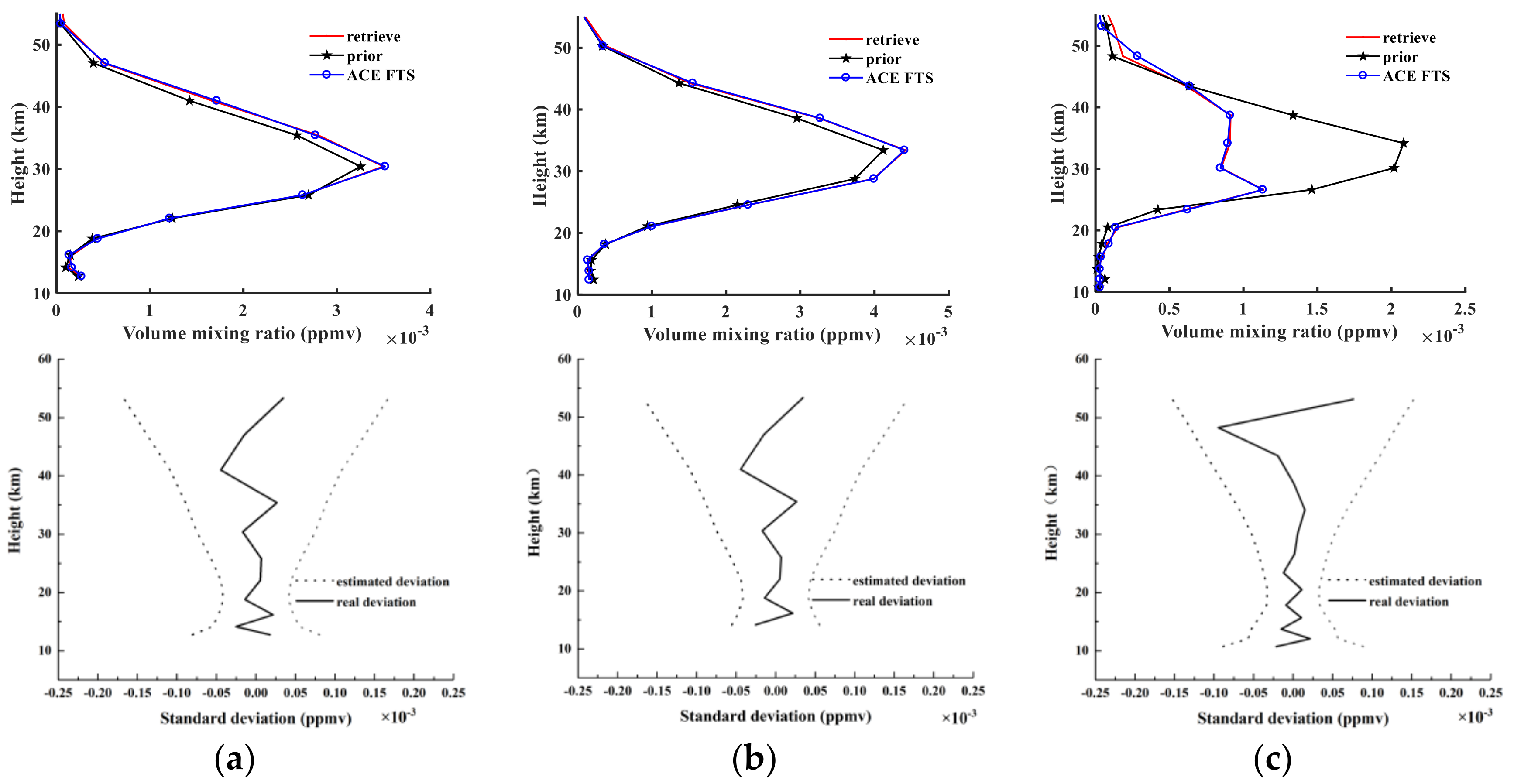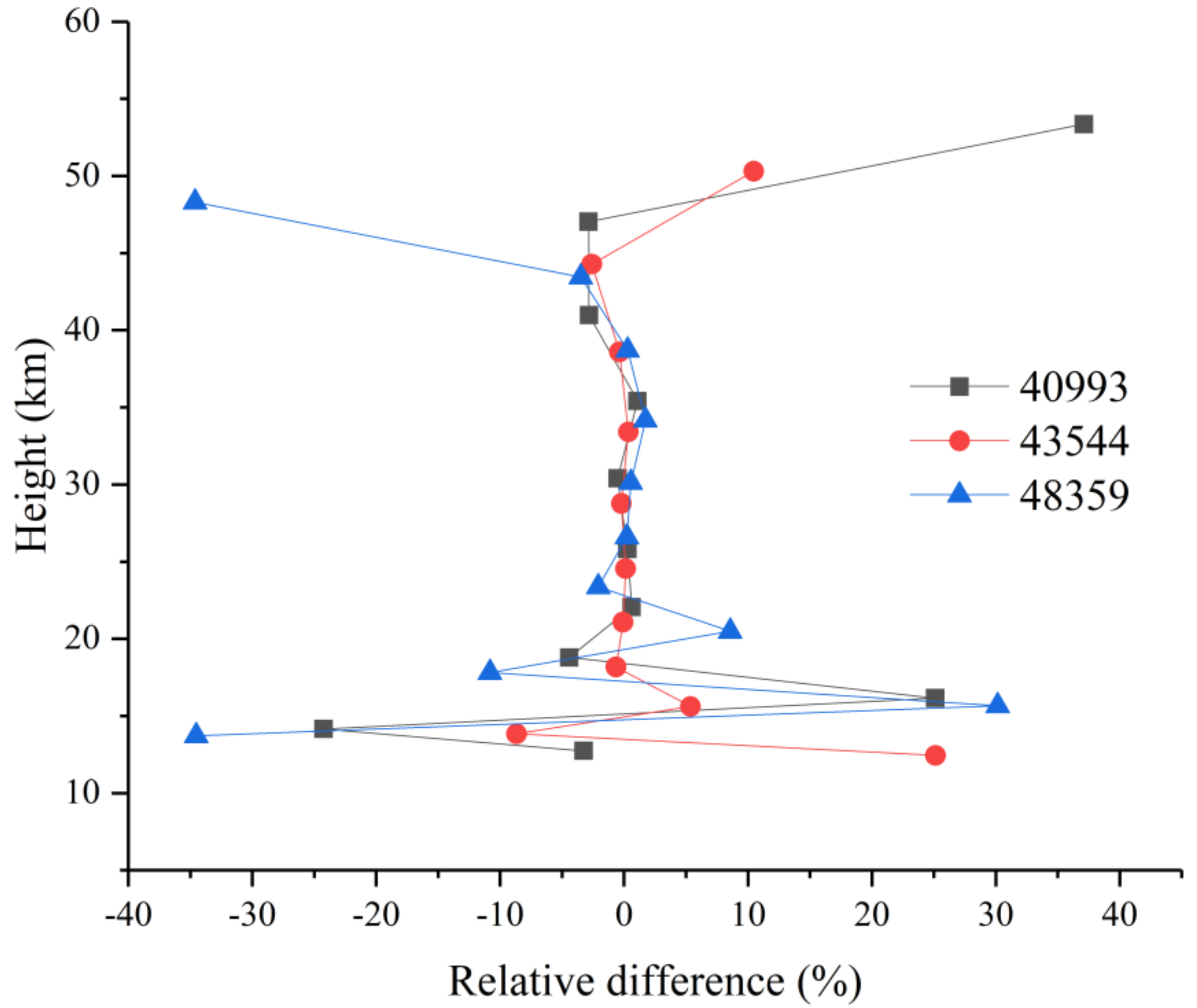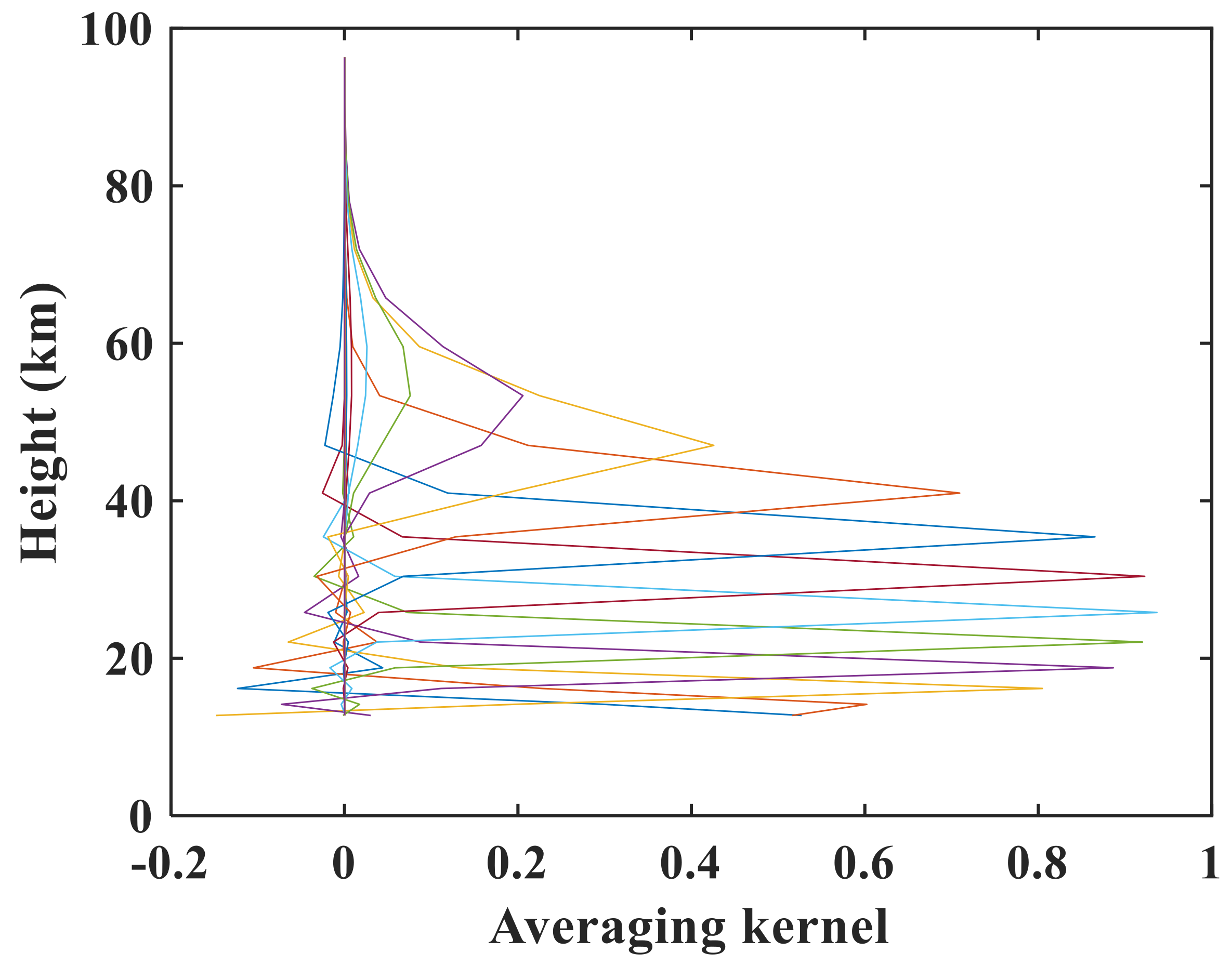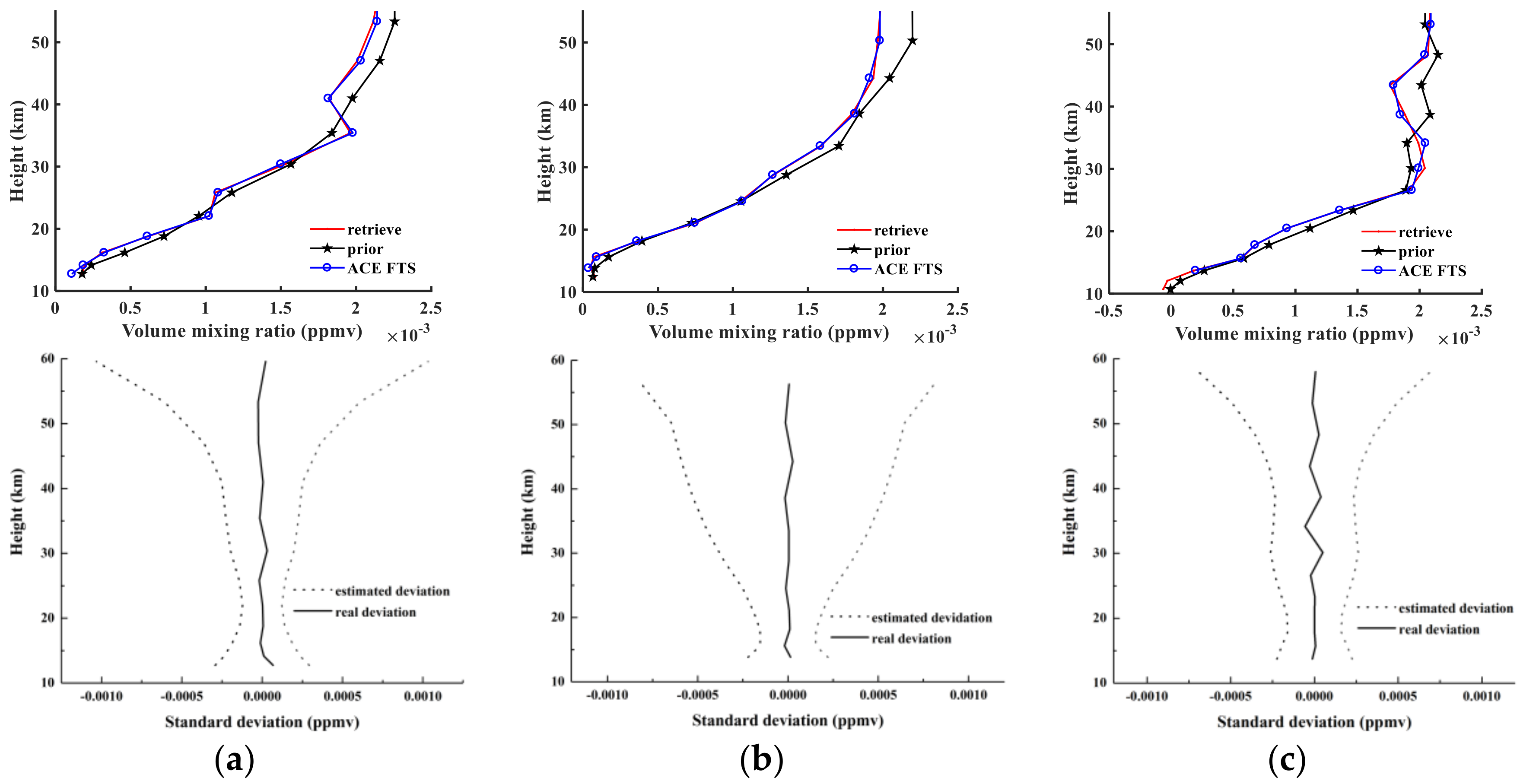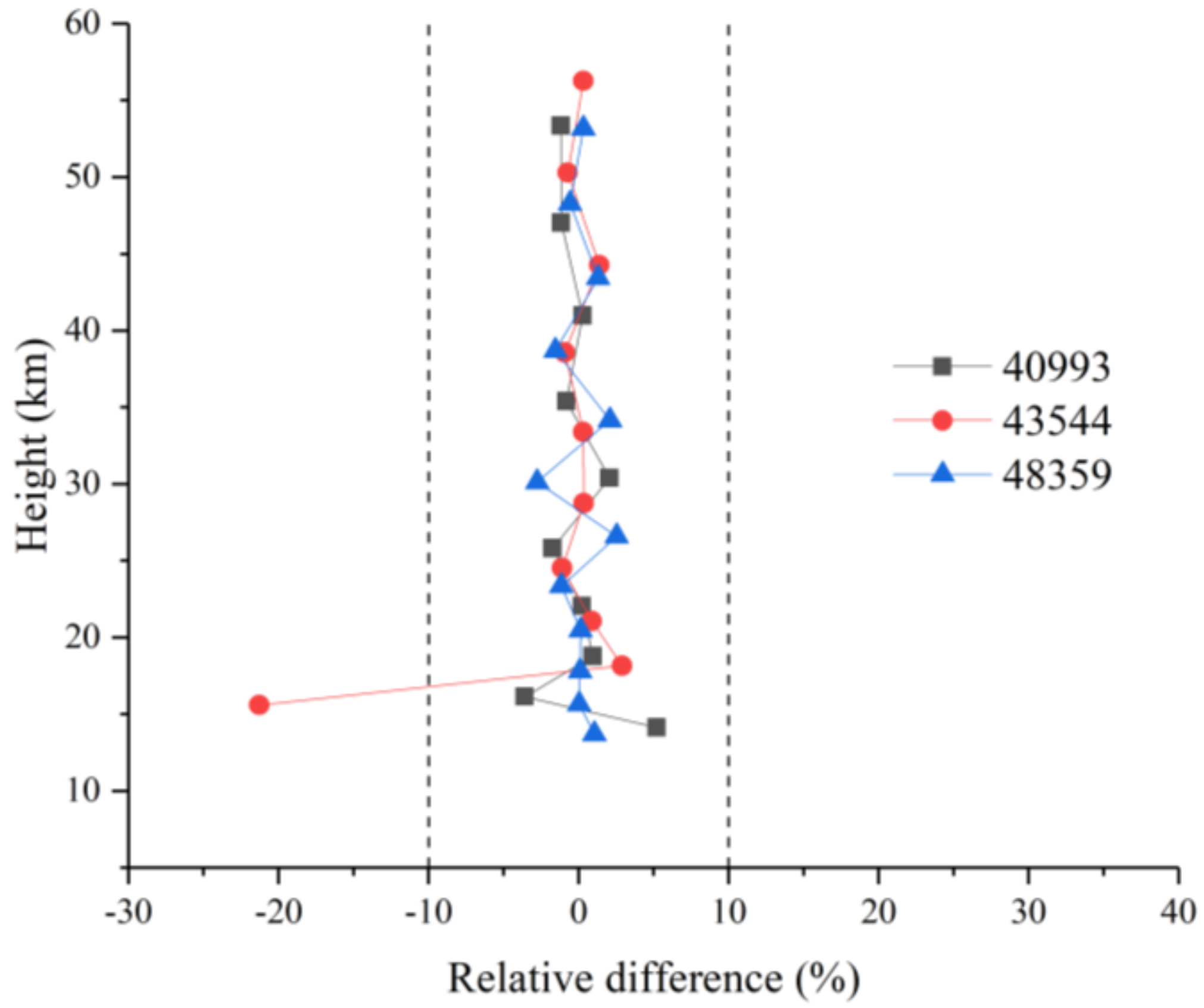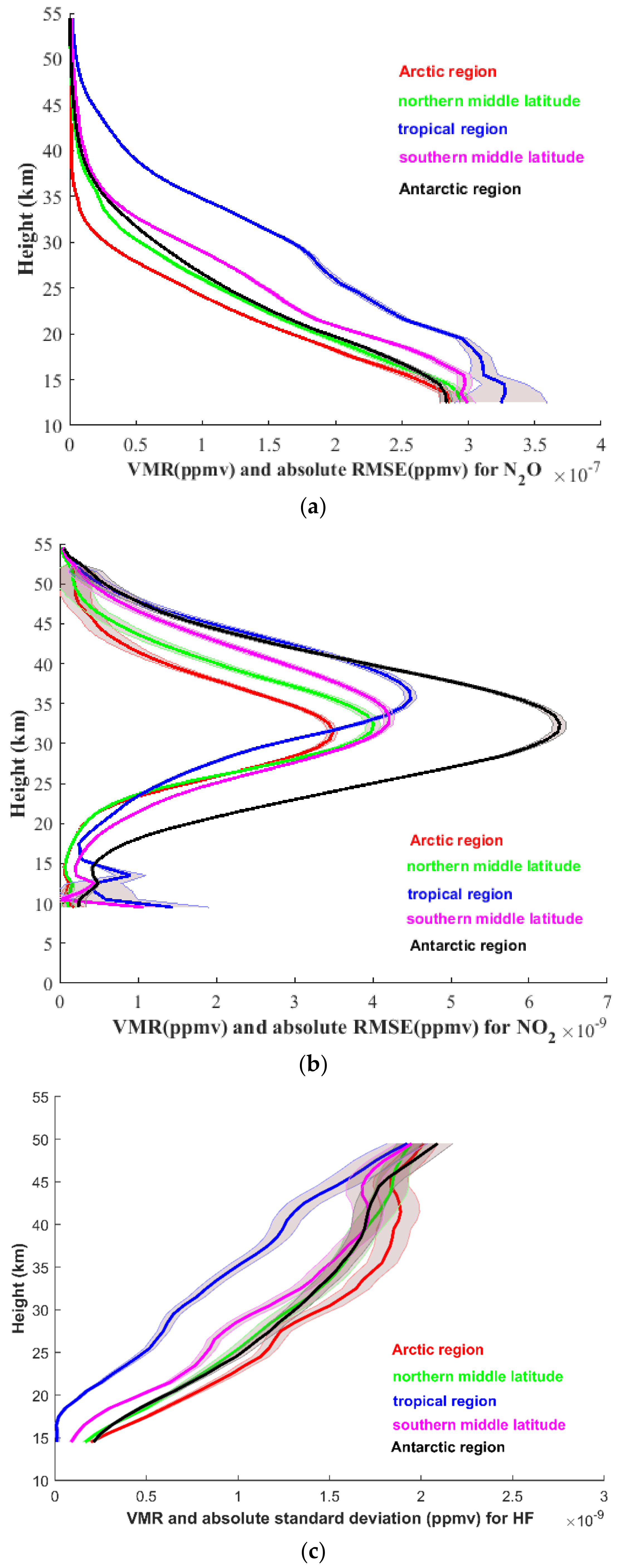1. Introduction
The Atmospheric Infrared Ultraspectral Sounder (AIUS) has a high spectral resolution of 0.02 cm
−1 while operating over a broad wavenumber range of 2.4–13.3 µm (750–4100 cm
−1). AIUS was designed to measure atmospheric absorption spectral sequences. These spectra, detected in the limb viewing geometry tangent heights, are inverted to obtain the vertical profiles of atmospheric constituents [
1]. The goal of AIUS is planned to measure the profiles of gases, such as O
3, H
2O, CO, HNO
3, NO, NO
2, N
2O, HCl, and HF, in the troposphere, stratosphere, mesosphere, and partial thermosphere above and surrounding Antarctica (50° S–90° S). This paper aims to is to test the retrieval performance by using synthetic measurements based on AIUS instrument characteristics for HF, NO
2, and N
2O. AIUS, which was launched on 9 May 2018, features instrument parameters that are similar to those of ACE-FTS. Therefore, three ACE-FTS level 2 profile products were assumed as the true profiles to simulate the spectra of AIUS for HF, NO
2, and N
2O. The Atmospheric Chemistry Experiment (ACE) was launched successfully into orbit on 12 August 2003, with a high inclination (74°) at 650 km [
2]. Its primary instrument is a high-spectral-resolution (0.02 cm
−1) infrared Fourier transform spectrometer (ACE-FTS), with a wavenumber range of 750–4400 cm
−1.
NO
2 and other nitrogen oxide constituents, commonly referred to as NO
x, are highly influential in atmospheric chemistry. As a precursor of photochemical smog, the chemical reaction of NO
2 with hydrocarbons is the main factor accounting for surface ozone pollution, which cannot be ignored in air pollution. The NO
x gas phase catalytic cycle destroys odd oxygen in the stratosphere, while NO
2 also plays a prominent role in determining the polar ozone budget [
3]. The primary sources of NO
x are fossil fuel combustion, vehicle emissions, biomass burning, lightning, and soil emissions, with anthropogenic emissions accounting for a substantial proportion of the total emissions. Nitrous oxide (N
2O) is the major source gas for nitrogen oxides in the stratosphere, a useful dynamical tracer, and one of the three main greenhouse gases (CO
2, CH
4, and N
2O). N
2O is of surface and near-surface origin, with approximately equal contributions from natural and anthropogenic emissions. As the only long-lived atmospheric tracer of human perturbations of the global nitrogen cycle [
4], tropospheric N
2O is transported through the tropical tropopause into the stratosphere, where approximately 90% is photolyzed in the wavelength range of 185–220 nm, generating N
2 and O. The remaining 10% is decomposed by the reaction with O(
1D) [
5]. HF, which is long lived in the stratosphere, is often used as a simple reference to other column observations of chemically active stratospheric components, such as HCl. The unique known sink of HF is transported to the troposphere, after which it is cleaned up by rainfall. The long lifetime of HF keeps fluorine chemistry from being a significant sink for stratospheric ozone. Therefore, this gas is a useful tracer of stratospheric motion and is often used as a reference for other chemically active tracers [
6].
Remote sounding of the Earth’s limb is currently the only method of observing the profiles of atmospheric constituents from the upper troposphere to the lower thermosphere. Many trace gases have their own signature in infrared bands, which are used to retrieve profiles by infrared occultation and limb sounders. Much of the research on N
2O, NO
2, and HF has been conducted using other occultation and limb instruments. ATMOS (Atmospheric Trace Molecule Spectroscopy), on board the Space Shuttle, was a Fourier transform infrared spectrometer. ATMOS operated on a broad band range of 600–4800 cm
−1 and could provide information about the chemical composition of the atmosphere, such as CO
2, O
3, CH
4, N
2O, CO, and H
2O in the troposphere, stratosphere, and mesosphere [
7]. Analyses of the retrieval volume mixing ratios (VMRs) of N
2O have been carried out through the middle atmosphere using 0.01-cm
−1 resolution infrared solar occultation spectra, which were recorded near 28° N and 48° S latitudes with ATMOS and were compared with results from other ground-, balloon-, and satellite-based instruments [
8]. HALOE (halogen occultation experiment) is carried on the high-atmospheric research satellite UARS (Upper Atmosphere Research Satellite), launched by NASA on 12 September 1991. The scientific goal of HALOE (2.45–10.04 µm) is to improve the understanding of the stratospheric ozone depletion related to ClO
y, NO
y, and HO
y by collecting and analyzing global data of key chemical components (O
3, HCl, NO, NO
2, HF, CO
2, etc.) while simultaneously observing the effects of fluorine on ozone [
9]. Measurements of NO
2 and HF are detailed and validated from HALOE in published papers [
10,
11]. ACE-FTS can be used to retrieve the vertical distribution of more than 30 kinds of atmospheric components, including O
3, H
2O, HCl, N
2O, CO, CH
4, NO, NO
2, and HF, from the surface to 120 km, and to study the atmospheric chemical and dynamic processes of the ozone distribution in the upper troposphere. VMR profiles of HF, N
2O, and NO
2 were retrieved from ACE-FTS, and the quality of ACE-FTS version 2.2 data was evaluated using other solar occultation measurements, including HALOE, SAGE II, SAGEIII, POAMIII, SCIAMACHY, stellar occultation measurements (GOMOS), and limb measurements (MLS, MIPAS, and OSIRIS) [
2,
3,
5,
12,
13]. MIPAS (Michelson Interferometer for Passive Atmospheric Sounding) is a limb-viewing Fourier transform spectrometer that sounded the emission of Earth’s atmosphere covering the spectral range from 685 to 2410 cm
−1 aboard the ESA (European Space Agency) Envisat satellite [
14]. The ESA operational almost real-time analysis provided vertical profiles of temperature and of VMR of H
2O, O
3, HNO
3, CH
4, N
2O, and NO
2 from pole to pole, approximately following the orbital track [
14]. The TES (Tropospheric Emission Spectrometer) is an instrument on the EOS Aura platform designed to study the Earth’s ozone, air quality, and climate. TES measured the spectral infrared (IR) radiances (650–3050 cm
−1) in a limb-viewing and a nadir (downward looking) mode. The scientific goal of TES is to detect the tropospheric O
3, CH
4, NO
2, NO, HNO
3, CO, and H
2O related to tropospheric O
3 chemical reactions [
15,
16]. Due to the high resolution and broad band range of AIUS, N
2O, NO
2, and HF profiles are retrieved and provide information for subsequent algorithms.
This manuscript is organized as follows. First, an overview of the optimal estimation method (OEM) and diagnostic tools, microwindow selection, atmospheric profiles and a priori profile, and forward model are introduced in
Section 2. Comparisons between the observed spectra and the simulated spectra and the retrieval process, in addition to the retrieval results and their assessment, are presented in
Section 3. A large number of simulation retrieval tests were conducted, and the results are analyzed in
Section 4. Finally, a summary and conclusions are offered in
Section 5.
2. Retrieval Scheme of N2O, NO2, and HF
Two crucial factors should be considered before retrieval: the pressure/temperature (P/T) and the tangent point. Reliable knowledge about atmospheric pressure and temperature is essential for the retrieval of VMR profiles [
17]. Consideration of the horizontal temperature gradients improves the retrieval accuracy. In addition, in many cases, such consideration reduces the number of convergence failures. In particular, near the polar vortex boundary, many retrievals have failed to converge when horizontal temperature gradients were neglected [
18]. Another crucial aspect of the P/T and trace gas retrieval process is pointing knowledge. The tangent height correction is determined before the retrieval of temperature and other trace gas profiles. The other two relevant issues for temperature retrieval and tangent height correction are prepared in advance. In this paper, the impacts of errors in temperature and tangent height on the inversion results are preliminarily evaluated.
2.1. Retrieval Algorithm
The reference forward model (RFM) is the forward model employed in the AIUS retrieval algorithm. The latest release version is v 4.36 (
http://eodg.atm.ox.ac.uk/RFM/index.html). The RFM can be applied for various measurement conditions, including nadir viewing, limb sounding, occultation observation, and balloon/aircraft measurements [
1]. The retrieval problem in atmospheric occultation sounding is how to extract the vertical profiles of the atmospheric state parameters from a sequence of the spectra of different tangent heights. The inversion algorithm adopted in this study is based on the OEM proposed by Rodgers [
18,
19]. The inversion method used in this study is adapted and modified according to the Qpack 2.0 retrieval software [
20]. Details regarding the retrieval algorithm are reported elsewhere [
1,
20,
21]. The retrieval algorithm is expressed as follows:
where
is a sequence of observations;
F denotes the forward model;
is the true state of the atmosphere and
represents a priori knowledge with an associated covariance matrix
;
Se is the covariance matrix of the observation error; and
K is the weighting function matrix. Here,
is not a fixed value related to atmospheric species, and the initial value is taken from an experimental result. In the iterative process, the constraint factor
must be adjusted and updated.
Considering the correlation between the different components of the state vector and the forward model vector, the definition of the a priori covariance matrix
can follow three functional types: Gaussian statistics, exponential, and linear form [
21]. Based on the retrieval test from the simulated data, the correction function employed in this study is the linear case, which can be expressed as follows:
where
i and
j denote the position of covariance matrix
;
is the standard deviation, calculated from a priori knowledge;
z is the position;
is the correction length; and |.| implies the absolute value.
Following Rodgers’ method, several powerful diagnostic tools were considered and were used as described below to assess the retrieval approach: the covariance matrix of the retrieved solution, averaging kernel matrix, vertical resolution, and degrees of freedom (DOFs). The covariance matrix of the solution includes the estimated error of the state parameters and the interlevel correlations and is given by
The vertical averaging kernel is the derivative of the retrieved profile with respect to the true profile [
12], which implies the weight of the true atmospheric state. For the optimal estimation formula, the averaging kernel matrix A is calculated as
where
is the retrieved profile and
is the gain matrix, which describes the sensitivity of the retrieval to the changes in the measurement. In the absence of a constraint in the least-squares problem (2), the averaging kernel matrix A is the identity matrix I (
). The vertical resolution of the retrieval as a function of A can be defined in several ways. Here, the vertical resolution is defined as the width at the half-maximum of the column of the averaging kernel matrix A. Due to regularization, the vertical resolution is typically wider than the tangent altitude spacing and is invariably wider than the grid on which the retrieval is performed [
18].
According to the trace of the averaging kernel, the number of DOFs is defined as
where the DOFs can be represented as the trace of the averaging kernel. If the DOFs is close to the dimension of the retrieving state vector, the retrieval result is determined by measurement information rather than by a priori knowledge.
2.2. Microwindow Selection
AIUS, a high-spectral-resolution spectrometer, has a strong correlation within channels and a similar spectral resolution and wavenumber range to ACE-FTS. Up to 69 microwindows are used in version 2.2 ACE-FTS for N
2O retrievals [
5], 11 microwindows are selected in version 3.5 ACE-FTS retrievals for HF, and 21 microwindows are employed for NO
2 retrievals [
3]. Fewer and narrower channels and microwindows, respectively, were adopted in this work relative to ACE-FTS for the retrieval of the N
2O, NO
2, and HF profiles. This simplification was implemented to improve computational efficiency while maintaining acceptable accuracy. Wavenumber ranges of 1120–1300 and 2200–2250 cm
−1 for N
2O, 1560–1642 and 2890–2940 cm
−1 for NO
2, and 3700–4110 cm
−1 for HF were selected based on these considerations.
Figure 1 presents the intensity and distribution of the N
2O, NO
2, and HF absorption lines at a temperature of 296 K. Microwindow selection was performed based on the sensitivity analysis for interference molecules and target composition and the entropy of information principles according to the set weight function threshold. The Shannon information content is a scalar quantity which is defined qualitatively as the factor (in bits). The microwindows selected for N
2O, NO
2, and HF are shown in
Figure 2. The
x-axis indicates the position of the microwindows in the spectral band, and the
y-axis represents the retrieval information at different tangent heights obtained from different microwindows. Finally, 126, 184, and 283 channels were selected for NO
2, N
2O, and HF, respectively. Number of channels (NC) and information content (IC) between ACE-FTS and simulating AIUS were computed and compared following equations of information content [
19], which are shown in
Table 1. ACE FTS used 2040 channels with 6.92 bits of IC and simulating AIUS used 184 channels with 6.3 bits of IC for N
2O retrieval. That is to say, simulating AIUS used 9% channels and retained 88% of the IC compared with ACE-FTS. Similarly, simulating AIUS has 6.69 bits of IC for NO
2 and 6.43 bits of IC for HF, respectively, corresponding to 7.38 bits of IC for NO
2 and 6.84 bits of IC for HF of AIUS. The probations of AIUS/ACE-FTS were 90% and 94% accordingly.
Small regions of the spectrum (generally 0.02 cm−1 for AIUS) contain the spectral features from a target molecule with minimal spectral interference from other molecules. However, for some molecules, it is impossible to find a comprehensive set of microwindows unaffected by significant interference. The following interference molecules were considered: H2O, O3, CH4, CH3Cl, CH3OH, H2CO, CO2, ClO, HCl, HNO3, NH3, N2O, NO, and OCS for NO2; CO2, CH4, H2O, H2O2, O3, CO, H2CO, HNO3, NH3, and SO2 for N2O; and O3, H2O, CO2, OCS, CH4, and N2O for HF.
2.3. Atmospheric Profiles
Profiles of the atmospheric species demonstrate a discrete atmospheric state at a specific time in a unique location. An integrated atmospheric profiles algorithm was proposed for the AIUS retrieving system that consists of ACE-FTS level 2 products, MLS global atmospheric products for the last 5 years, and profiles from the AFGL (Air Force Geophysics Laboratory) atmospheric models. The integrated profiles of AIUS start from the surface with a grid width of 1 km and reach upward to as high as 120 km [
1].
Rodgers [
18,
19] proposed the OEM based on the Bayesian theory, introducing an a priori profile to define the range of solutions. The reasonable selection of the a priori profiles and the correct estimation of the a priori error strongly influence the stability, speed, and accuracy of calculations, especially for trace species such as N
2O, NO
2, and HF. Therefore, a series of a priori profiles were constructed based on the level 2 products of ACE-FTS (
https://databace.scisat.ca/level2/ace_v3.5_v3.6/FLAG/), named ACEFTS_L2_v3p6_*.nc, where * is the name of the target species, for example, O
3. The a priori profiles for N
2O, NO
2, and HF were used to regularize the retrieval and to contribute structure to the retrieval that was not actually measured. The following steps were carried out to build the database of the a priori profiles.
Profiles from file ACEFTS_L2_v3p6_*.nc are retrieved and classified by month and further divided by the latitude and longitude spacing of 5° and 30°, respectively.
By eliminating the invalid values of the profiles that fall in the same grid and calculating mean values, files for the a priori profiles are generated. We call these the database of the fine grid profiles.
Due to the incomplete coverage area of the ACE-FTS products, not all grids have an a priori profile. In view of this situation, another approach is adopted. Due to the coverage of AIUS around the Antarctic (50–90° S), profiles in this region are collected, processed by season, and averaged. We call this set of the obtained a priori profiles a database of the coarse grid profiles that are used when the fine grid profiles are lacking.
Following the date and location of inversion, three a priori profiles of the a priori data from the database of fine grid profiles were selected for HF, N2O, and NO2 inversion in this study and were then interpolated onto the retrieval grid.
4. Statistical Analysis
To further assess the simulation retrieval algorithm, a large number of retrieval tests were performed for each component in May 2018. To verify the generalizability of the inversion algorithm in the global region, the selected experimental areas cover the Arctic region (~75° N), northern middle latitude (~45° N), tropics (~5° N), southern middle latitude (~45° S), and Antarctic region (~75° S). Hundreds of retrievals were conducted separately in each region related to N
2O, NO
2, and HF species, and both the VMR profiles and the absolute standard deviations in each region were all averaged.
Figure 18 lists the mean VMR profiles of the retrieval results and the averaged absolute standard deviations. Each curve of a specific color represents a different region (the red curve represents the Arctic region, the green represents the northern middle latitude, the blue is the tropical region, the magenta is the southern middle latitude, and the black is the Antarctic region). Overall, the trends of the mean VMR profiles and the averaged absolute standard deviations of the three species (N
2O, NO
2, and HF) are consistent with the results in
Section 3. However, great variation in mean VMR profiles occurs in each region.
The VMR of N
2O generally increases with increasing altitude, as shown in
Figure 18a. The averaged absolute standard deviations are 0.1 × 10
−7 ppmv, except in the lower altitude (below 20 km, with a maximum value of ~0.5 × 10
−7 ppmv) of the tropical region. The VMR of N
2O is larger in the tropics than in the other four regions, and the minimum VMR of N
2O is in the Antarctic region.
Figure 18b shows the results for NO
2. The averaged absolute standard deviations of NO
2 show a low standard deviation in the stratosphere and relatively higher standard deviations below 15 km and above 45 km. The maximum VMR of NO
2 exists in the Antarctic region, and the minimum occurs in the Arctic region. This characteristic differs from the VMR profiles of N
2O.
The VMR of HF in the bottom panel of
Figure 18 increases with altitude, and the value is larger in the Arctic region and the Antarctic region than in the other regions, whereas the tropical region has the minimum VMR of HF. Compared with N
2O and NO
2, the absolute standard deviation of HF is relatively larger in the altitude range of 25–50 km, with a maximum absolute standard deviation of 10
−7 ppmv at the altitude of 40 km in the Arctic region. According to the results of retrieving quantities of profiles and computing the absolute standard deviation, the AIUS system can generally maintain stability and ensure precision.
5. Conclusions
This study employs the OEM and RFM to retrieve three orbits of N2O, NO2, and HF profiles. The overall absolute and relative RMSE, the relative errors at different tangent heights between the retrieval results, and the ACE-FTS products are calculated to analyze the differences. To accurately characterize the retrieval algorithm, we also calculate the estimated deviation and real deviation. Finally, several diagnostic tools, such as the vertical resolution, averaging kernel, and number of DOFs, are used to assess the inversion model of AIUS. Before the analysis of retrieval results, the impacts on the retrieval results caused by errors in temperature and tangent height are discussed. The errors in temperature and tangent height mostly affect the precision below the lower stratosphere. The analysis results are as follows.
For the N2O retrieval results, the absolute RMSE values of the three orbits are 0.0056, 0.0062, and 0.0059 ppmv, and the corresponding relative RMSE values are 6.37%, 25.83%, and 12.59%. The relative errors are smaller than 6% at altitudes below 25 km and are larger in the 25–45 km range, with a maximum value of 25%. At most altitudes, the absolute real deviation is less than 0.001 ppmv, which is within the estimated deviation. The N2O retrieval information is mainly derived from the observed spectra, not from the a priori profiles.
For NO2, when the a priori profiles show large deviations from the ACE-FTS results and the shape is different, the retrieval results can also fit the actual values quite well. The absolute RMSE values are 2.78 × 10−5, 2.15 × 10−5, and 1.32 × 10−5 ppmv, and the relative RMSE values do not exceed 5% in the middle and upper stratospheres. Even though the estimated deviations increase continuously with height, the real deviations fluctuate within the estimated deviations. The inversion for NO2 is constrained by the a priori profile below 20 km and above 45 km.
We obtain better HF retrieval profiles with absolute RMSE values of 2.65 × 10−5, 4.54 × 10−5, and 2.97 × 10−5 ppmv and corresponding relative RMSE values of 2.36%, 14.54%, and 2.58%, except for one tangent point of sunrise orbit 43544. Almost all the relative errors are controlled within 5%, and the real absolute deviations vary around a relatively small value. Similar to N2O, the retrieval results are influenced by the observed spectra.
Finally, the retrieval method is applied in five regions in the global region. For each species, one hundred retrieval tests are performed, and a preliminary analysis of the VMR profiles and the standard deviation is performed. The trends of the mean VMR profiles and the averaged absolute standard deviations of the N
2O, NO
2, and HF are consistent with the results in
Section 3. However, great variation in mean VMR profiles occurs in each region. The VMR of N
2O is larger in the tropics than in the other four regions, and the minimum VMR of N
2O is in the Antarctic region. With a different characteristic from the VMR profiles of N
2O, the maximum VMR of NO
2 exists in the Antarctic region, and the minimum occurs in the Arctic region. The VMR of HF is larger in the Arctic region and the Antarctic region than in the other regions, whereas the tropical region has the minimum VMR of HF. Generally, the AIUS system can maintain stability, and precision can be ensured.
In our AIUS retrieval system, we use reliable a priori knowledge for the initial estimations in the inversion model and integrate atmospheric profiles for the forward model, and the obtained results meet our expectations. However, the retrieval process is based entirely on the ACE-FTS data rather than on the AIUS real measurement data. Currently, AIUS is in an in-orbit test period; therefore, all of these results will be recalculated using the real measurement data at a later date.
